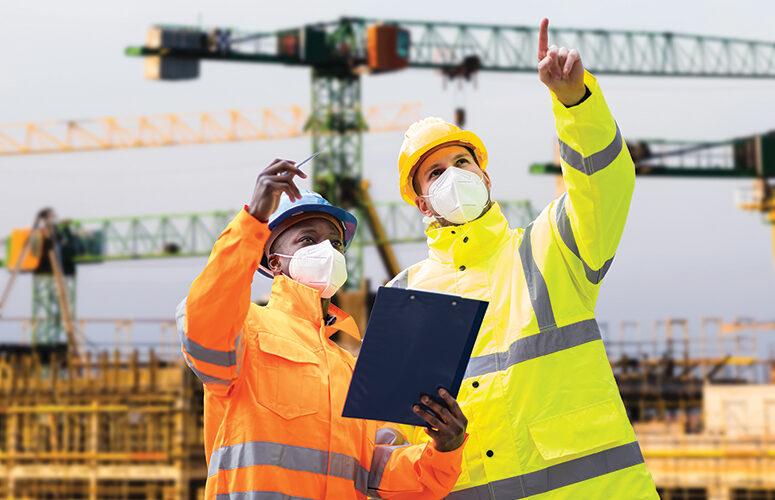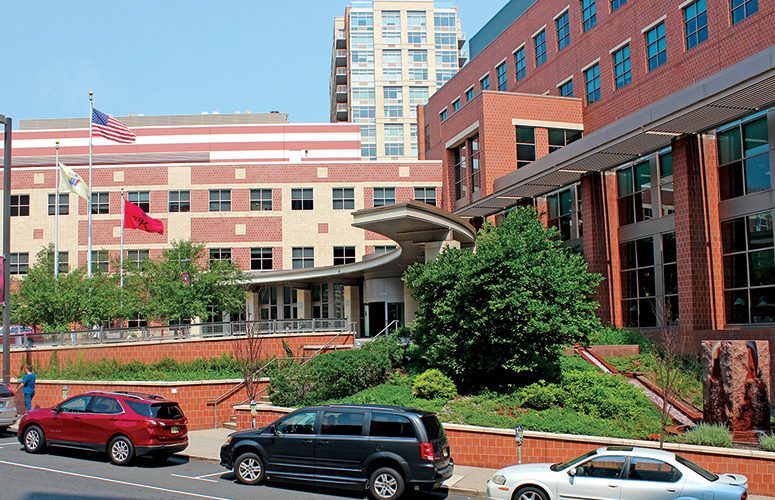
Construction Sites and COVID-19
Pre and post pandemic, the construction trades lead the way in worker safety equipment and procedures.
By Vince Baglivo, Contributing Writer On May 17, 2021On April 8, 2020, Gov. Phil Murphy issued Executive Order No. 122, shutting down all “non-essential” construction in the state, noting that “construction sites are inherently difficult environments for social distancing to occur, as they frequently require large numbers of individuals to touch the same surfaces, gather closely together in areas such as service elevators, and use common facilities such as portable restrooms.”
Notable exceptions, including projects necessary for the delivery of healthcare and essential services, and transportation projects, kept many job sites up and running. The governor’s subsequent Executive Order No. 142 in May, permitting non-essential construction projects and non-essential retail businesses to reopen as part of “The Road Back: Restoring Economic Health Through Public Health” plan, helped bring even more people back to work, but demanded strict protocols to keep their workplaces safe.
“We were pleased at the beginning of the crisis to have worked on the [trades’] behalf with Gov. Murphy and his administration to keep so much construction essential,” Jack Kocsis Jr., chief executive officer, Associated Construction Contractors of New Jersey (ACCNJ), notes. “We were able to maintain thousands of jobs at a time when tens of thousands of New Jerseyans suddenly found themselves without jobs. Our members and the trades immediately took on the responsibility of keeping everyone safe and, in a way, comfortable on the job sites.”
For many businesses, this required a massive investment in personal protective equipment (PPE), redesign, rescheduling, reprogramming, and other measures to ensure the health and welfare of workers, customers and vendors. Construction trades, while still challenged to raise the bar on job site safety, had years of experience and preparation in place before the pandemic.
“In some ways, I think our members were better suited than other sectors to adjust to COVID-19 protocols,” IBEW Local 102 President Bernie Corrigan says. “The construction industry has always embraced the world of PPE. Safety equipment and procedures are part of our everyday life, so when masks were mandated, it was just another step in the process. Masks were not uncommon on construction sites prior to COVID, nor was working in hazardous locations, so our members know how to navigate these situations and work in the safest possible manner.”
For decades, the Eastern Atlantic States Regional Council of Carpenters has followed the Infection Control Risk Assessment (ICRA), created to determine best practices in healthcare construction. Established in 2000, ICRA mitigates the risks associated with construction activities to reduce the spread of viruses, bacteria, mold and other workplace contaminants. While its most prominent use is within hospitals, it can and should also be utilized in senior living facilities, VA and other off-site medical centers. The expansion of its use is now more important than ever due to the ongoing threat of the pandemic.
According to the Carpenters Council, approximately 99,000 people die in hospitals every year due to secondary infections contracted during their stays. One of the major causes of secondary infections is cross contamination, which can occur during hospital remodels. The removal of ceilings, walls, flooring, etc. releases agents that may be trapped behind ceilings and walls, and under floors. If not handled properly, these infectious agents are transferred through HVAC systems, drafts, feet tracking, etc. to other areas of the hospital occupied by patients with compromised immune systems who are more likely to be susceptible to secondary infections.
Healthcare facilities require contractors and workers who have been trained to handle these situations during construction. The knowledge gained now informs a wide range of construction projects during the continued COVID-19 fight. And, the Eastern Atlantic States Regional Council of Carpenters, through the Carpenters International Training Fund (CITF), provides ICRA training and qualification to members at both the apprentice and journeyman level.
Throughout the pandemic, healthcare and other frontline essential workers have received deserved praise and thanks for their heroic efforts. At the same time, other essential workers, including construction workers, went unsung.
“A good portion of our members faced many of the same challenges the healthcare community struggled with,” IBEW Local 102’s Corrigan points out. “They worked in hospitals and were on hand to build and maintain the temporary testing and vaccination sites throughout our state. We were not alone; the building trades community joined many of our neighbors going to work every day over the past year ensuring that New Jersey continued to move forward.”
Looking ahead, ACCNJ’s Kocsis says he is optimistic. “When we started 2020, we were looking forward to the strongest performance in our industry since the Great Recession. We had only begun to recover in 2016. Now, less than five years later, jobs that were in the pipeline disappeared or were delayed,” he adds. “Despite vaccinations, our economic forecasts predict a bleak 2021 before work begins to pick up again in 2022.
Calling it a “once-in-a-generation investment in America,” President Biden in March announced a $2-trillion plan to rebuild and upgrade infrastructure, including roads and bridges, among other key boosts to the economy and job creation. Opportunities for union contractors abound in the scope and depth of the initiative to “build back better.”
“Warehouses are planned all over the state, north and south. Online ordering of all goods, which we know had been rapidly ramping up, became absolutely the norm in 2020. So, the demand for industrial complexes like sophisticated cold-storage facilities and state-of-the-art distribution centers hasn’t stopped and won’t stop,” Kocsis says. “Vacancy rates continue to fall and per-square-foot lease rates continue to rise. It’s a tremendous investment for developers, a good ratable for municipalities, and a huge opportunity for our contractors. Multi-family and mixed-use developments are promising this year and even more likely going forward. Non-hospital healthcare facilities and education construction will pick up.”
Kocsis adds, “New Jersey has the tools to foster growth, including: the recent New Jersey Economic Development Authority incentive package signed into law at the end of 2020, P3 legislation, and the New Jersey Infrastructure Bank, with new programs and new funding to cover more construction with low-cost loans.
“We represent the best contractors, who hire the most highly skilled craftworkers,” Kocsis continues. “Together, we have weathered the unexpected challenges of COVID-19 with imagination, determination and fortitude. Because of that grit and talent, the people of New Jersey continued to receive the essential building, utility, highway, bridge and transit infrastructure they needed to get through this devastating pandemic.”
To access more business news, visit NJB News Now.
Related Articles:





